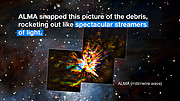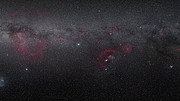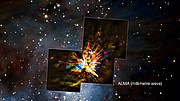ALMA and VLT views of an explosion in Orion
Videos

ESOcast 102 Light: Dramatic Stellar Fireworks (4K UHD)

Zooming in on an explosive event in Orion
Stellar explosions are most often
associated with supernovae, the spectacular deaths of stars. But new
ALMA observations provide insights into explosions at the other end of
the stellar life cycle, star birth. Astronomers captured these dramatic
images as they explored the firework-like debris from the birth of a
group of massive stars, demonstrating that star formation can be a
violent and explosive process too.
1350 light years away, in the constellation of Orion (the Hunter), lies a dense and active star formation factory called the Orion Molecular Cloud 1 (OMC-1), part of the same complex as the famous Orion Nebula.
Stars are born when a cloud of gas hundreds of times more massive than
our Sun begins to collapse under its own gravity. In the densest
regions, protostars ignite and begin to drift about randomly. Over time,
some stars begin to fall toward a common centre of gravity, which is
usually dominated by a particularly large protostar — and if the stars
have a close encounter before they can escape their stellar nursery,
violent interactions can occur.
About 100 000 years ago, several protostars
started to form deep within the OMC-1. Gravity began to pull them
together with ever-increasing speed, until 500 years ago two of them
finally clashed.
Astronomers are not sure whether they merely grazed
each other or collided head-on, but either way it triggered a powerful
eruption that launched other nearby protostars and hundreds of colossal
streamers of gas and dust out into interstellar space at over 150
kilometres per second. This cataclysmic interaction released as much
energy as our Sun emits in 10 million years.
Fast forward 500 years, and a team of astronomers led by John Bally (University of Colorado, USA) has used the Atacama Large Millimeter/submillimeter Array
(ALMA) to peer into the heart of this cloud. There they found the
flung-out debris from the explosive birth of this clump of massive
stars, looking like a cosmic version of fireworks with giant streamers
rocketing off in all directions.
Such explosions are expected to be relatively short-lived, the
remnants like those seen by ALMA lasting only centuries. But although
they are fleeting, such protostellar explosions may be relatively
common. By destroying their parent cloud, these events might also help
to regulate the pace of star formation in such giant molecular clouds.
Hints of the explosive nature of the debris in OMC-1 were first revealed by the Submillimeter Array in Hawaii in 2009. Bally and his team also observed this object in the near-infrared with the Gemini South telescope in Chile, revealing the remarkable structure of the streamers, which extend nearly a light-year from end to end.
The new ALMA images, however, showcase the explosive nature in high
resolution, unveiling important details about the distribution and
high-velocity motion of the carbon monoxide
(CO) gas inside the streamers. This will help astronomers understand
the underlying force of the blast, and what impact such events could
have on star formation across the galaxy.
More Information
ESO is the foremost intergovernmental astronomy organisation in Europe
and the world’s most productive ground-based astronomical observatory by
far. It is supported by 16 countries: Austria, Belgium, Brazil, the
Czech Republic, Denmark, France, Finland, Germany, Italy, the
Netherlands, Poland, Portugal, Spain, Sweden, Switzerland and the United
Kingdom, along with the host state of Chile. ESO carries out an
ambitious programme focused on the design, construction and operation of
powerful ground-based observing facilities enabling astronomers to make
important scientific discoveries. ESO also plays a leading role in
promoting and organising cooperation in astronomical research. ESO
operates three unique world-class observing sites in Chile: La Silla,
Paranal and Chajnantor. At Paranal, ESO operates the Very Large
Telescope, the world’s most advanced visible-light astronomical
observatory and two survey telescopes. VISTA works in the infrared and
is the world’s largest survey telescope and the VLT Survey Telescope is
the largest telescope designed to exclusively survey the skies in
visible light. ESO is a major partner in ALMA, the largest astronomical
project in existence. And on Cerro Armazones, close to Paranal, ESO is
building the 39-metre European Extremely Large Telescope, the E-ELT,
which will become “the world’s biggest eye on the sky”.
Links
- Research paper (Bally et al., in the Astrophysical Journal).
- Photos of ALMA
Contacts
John Bally
University of Colorado, USA
Email: john.bally@Colorado.EDU
Richard Hook
ESO Public Information Officer
Garching bei München, Germany
Tel: +49 89 3200 6655
Cell: +49 151 1537 3591
Email: rhook@eso.org
Source: ESO



